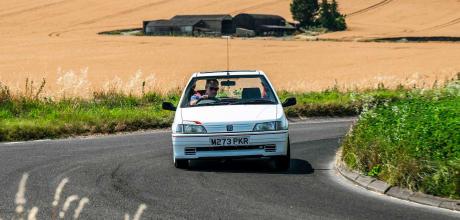1993 Peugeot 106 Rallye Series 1
Its 1.3-litre engine produces a mere 100bhp and its top speed is just 118mph. But the Series 1 Rallye has motorsport in its DNA, an insatiable appetite for revs and real genius in its handling. Proof that evo icons can come in the humblest of packages.
Words by Adam Towler
Photography by Aston Parrott
ICON: PEUGEOT 106 RALLYE
Its stats may have been modest, but the original 106 Rallye delivered a driving experience that no other hatch could match. Former Rallye owner Adam Towler gets back behind the wheel.

The view through the little Peugeot’s deep windscreen is almost entirely fields – expansive, gently rolling hills of sun-bleached crops as far as the eye can see, baked almost to the colour of Weissbier under an unrelenting sun. Toasty air blasts through the wound-down side windows and small, open sunroof, coquettishly positioned upwards and rearwards in the slipstream following a few revolutions of the frail plastic handle behind the rear-view mirror. It’s no match for air conditioning, but it does the job; stationary, though, the 40-degree heat is enough to have my forearms literally wringing wet with sweat in mere seconds.

If I didn’t know better I’d swear we were somewhere past Reims, sailing along a French N-road, driving one of Peugeot Sport’s absolute belters on its home soil, but I do – a few miles ahead lies Wantage, Oxfordshire, roasting in record temperatures. At least three people today have already said ‘You’ll cook today in that without air con!’, but you know what? I couldn’t care less. It’s been 26 years since I last drove a Series 1 106 Rallye, the first sporting car I ever owned, and it feels like coming home. Getting a sweat on isn’t going to spoil that.
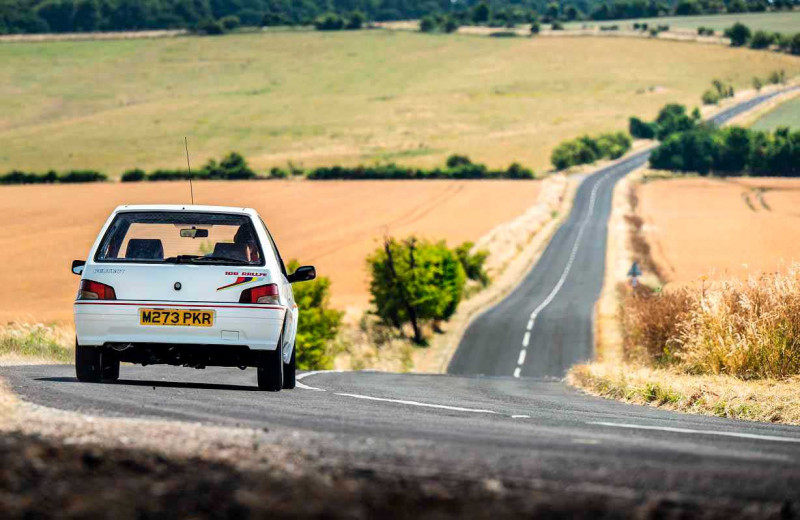
I can’t help but feel a bit partisan about this evo Icon. It was similarly hot the first time I ever saw one in the metal, queuing for the ferry at Portoferraio docks on the Isle of Elba. It was the summer of 1995, and the heat haze rose off the melting asphalt, merging with the pungent whiff of fish and heavy ship oil. It was too hot to move; too hot to breathe. There, amongst a long line of scruffy Fiats and comically decrepit Renaults, was a brand new, gleaming black, 106 Rallye, its cool young owner reclining in the driver’s seat, his attractive female companion looking bored alongside. It had those motorsport stripes, it had white steel wheels, and most importantly to a nerdy, rally-obsessed young bloke like me, it had an FIA homologation plaque under the bonnet that denoted the small production run of this vibrant little car was for the ultimate purpose: it was a homologation special. I knew there and then I had to have one, and, not too long afterwards, I did.
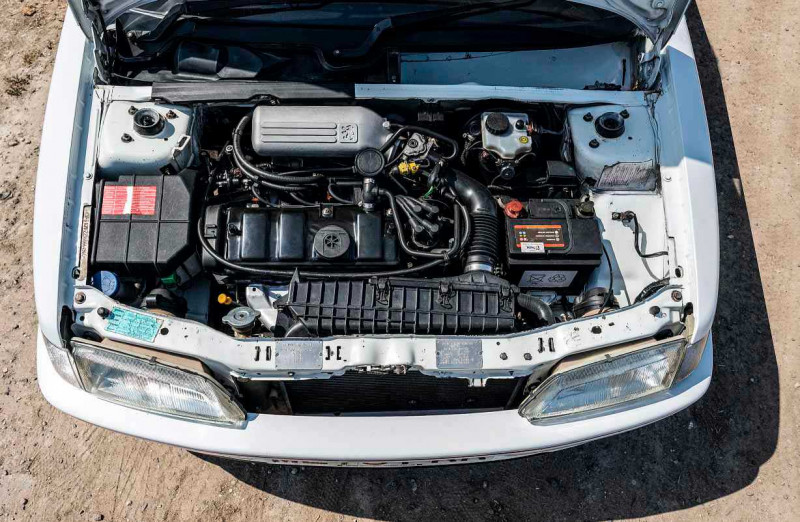
Then again, I already knew it was special, having devoured what information I could from the pages of Performance Car magazine, and not just first drives and group tests but also on the long-term test fleet, where then-editor (and current evo contributor) Brett Fraser ran a red example that in time he modified.
Designed for Group A and N rallying, the Series 1 Rallye picked up where the 205 Rallye left off. The latter was a car we never got officially in the UK (even though there was a cooking badge-engineered 205 of the same name over here). It used a specially downsized version of Peugeot’s new-for-the-’80s TU series engine to fit in the ‘up to 1300cc’ class. Known as the TU2, this oversquare four-cylinder, eight-valve motor first appeared in the Citroën AX Sport, but in the 205 Rallye was good for 102bhp when breathing through twin Weber DCO40 carbs. The featherweight Rallye (just 795kg!) became a legend, both on-road and in the hands of clubman rally competitors in Europe, so creating a replacement based on the 106 was an obvious path to take.
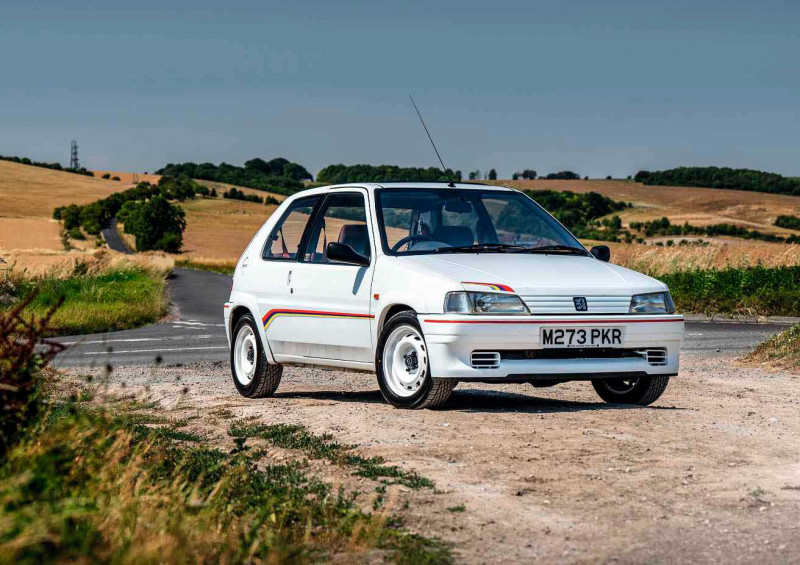
The 106 had first appeared in 1990, part of a little ‘n’ large duo along with the much bigger 306 that somehow never quite managed to completely replace the 205, although they were excellent cars in their own right. A performance 106 arrived in 1991 in the form of the XSi, powered by a 1.4-litre, 100bhp TU series engine, but for the Rallye of 1993 Peugeot Sport turned once again to the TU2, this time in ‘J2’ guise. It now had Magneti Marelli fuel injection, and the compulsory catalytic converter, but it still managed 100bhp at 7200rpm, along with a rather meagre 80lb ft of torque at a laughably peaky 5400rpm.
The new Rallye weighed 825kg, and was basic in the extreme: no power steering, little in the way of door trims, wind-up windows, a cheap radio/cassette player and no driving lights. Inside there were red carpets and seatbelts, and sporty seats in black with a unique fleck pattern, while outside were unique arches: colour-coded and that took the shape of the arch unlike the 205 GTI-style unpainted items on the XSi. And, of course, white-painted 14-inch steel wheels and Peugeot Sport stripes, remixed for the ’90s and applied to the bonnet, sides and rear hatch. Complementing the Rallye’s high-revving engine was a very-close-ratio, five-speed gearbox, with top equating to around 4000rpm at 70mph. The chassis was almost identical to the XSi’s, but thicker anti-roll bars were used; drum brakes remained on the rear axle, and wouldn’t change to discs until the Series 2 (more on which in a bit).

Andy Powell’s white Series 1 positively glows in the direct sunlight. The UK received 1000 cars, with white, red and black the only colours available. Options extended to a sunroof and little else, but then the Rallye did cost under £10,000 new, making it something of a bargain even then. This is Andy’s second, having owned one 20 years ago, and it’s a beauty despite showing over 140,000 miles on the clock. He’s clearly passionate about the cars, having set up a database on Instagram to log the survivors.
I open the driver’s door and it creaks on its hinges like all old Peugeots seem to do, revealing an interior that might as well have been created on a different planet, let alone nearly 30 years ago. It is disarmingly simple. Ahead a gauge pack featuring simple Jaeger dials: coolant and oil temp gauges in either corner, larger tachometer and speedometer in the centre. The oil gauge also acts as an electronic dipstick on start-up. The irony isn’t lost on me that in the cars I’ve been driving mainly this past month – the BMW M240i and Audi RS3 with fully electronic displays – such clarity and immediacy of vital driving information seems beyond them, but not so the most basic of Peugeots from nearly 30 years ago…

You sit relatively high. The pedal box is small. There’s a lot of glass area, and not for the first time I reflect on the double-edged sword that is the light, airy interior of old cars juxtaposed with the obvious fragility of them in a crash. By modern standards – or even those of 20 years ago to be fair – you were vulnerable in a 106 in the advent of a major impact. It’s time to go. Twist the simple key and the little TU fires without much fanfare, exhaling through the quiet standard exhaust. There’s a little more movement of the gearlever in gear than I remember, but the shift is light and not without some tactility. That short gearing and light weight means the Rallye just springs off the line, zipping up the revs and quickly adding an initial 20mph to get things underway.
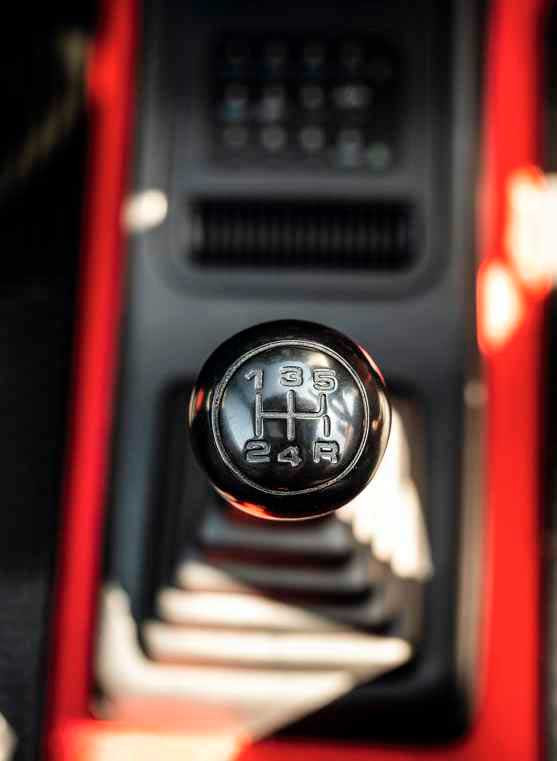
The first miles are a surprise. Like so many great, analogue, modern classics, the Rallye is nothing like as hard-edged as you might imagine it to be. The unassisted steering is relatively heavy at parking speeds (although nothing like that of an unassisted 205 GTI 1.9) and is also low-geared; the weight falls away as the speed rises but not a lot happens initially either side of the straight-ahead. The damping is pretty relaxed too, and there’s some obvious initial body-roll that just wouldn’t be part of a modern car’s make-up. It actually makes the Rallye quite a laid-back drive, despite its reputation, and it’s an easy car to potter around in – small on the road, undemanding, great visibility. I suppose it’s just how small cars used to be. The performance is tepid, at best. Anyone used to an old PSA product will recognise the thin, slightly tappety engine note, but its dearth of low-down muscle means that once you’re past the first-gear sprightliness, at lower revs you’re just keeping up with traffic at best. Inclines can be more of a challenge – the Rallye just doesn’t have the biceps, and can actually bleed off speed even under full throttle if you’ve the wrong gear.
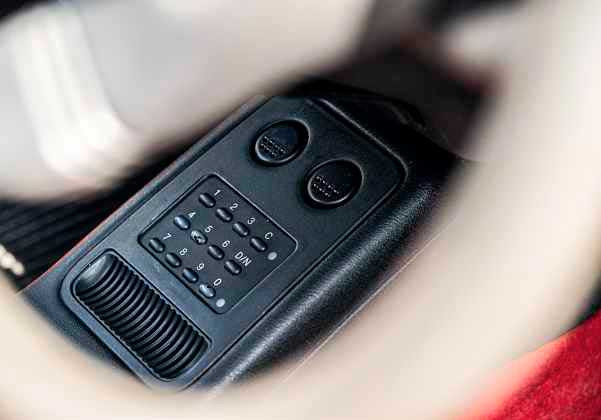
The remedy, of course, is revs. Lots of them. By 4000rpm the 106 is making pleasing growling noises, and past 5000rpm it’s properly on-cam, building to that 7200rpm red line and power peak. It sounds fabulously keen and there’s real energy here, which you are forced to sustain via working that chicken drumstick of a gearlever around the gate as fast as possible. It’s the sort of car where dancing on the pedals is as enjoyable as it is a must, and that’s how we’re now rowing along, sweeping between fast curves, braking and blipping down for tighter corners, extending the engine through the gears on the way out and down the next straight. I am completely engrossed in the process, revelling in every moment. And then I glance down and realise that we’re travelling at an indicated 62mph. I laugh out loud. That’s absurd. All that fun, that sensation of speed and being ‘on it’, and in real terms we’re not even breaking the speed limit. What a wonderful reality; a brilliant car for our times, don’t you think?
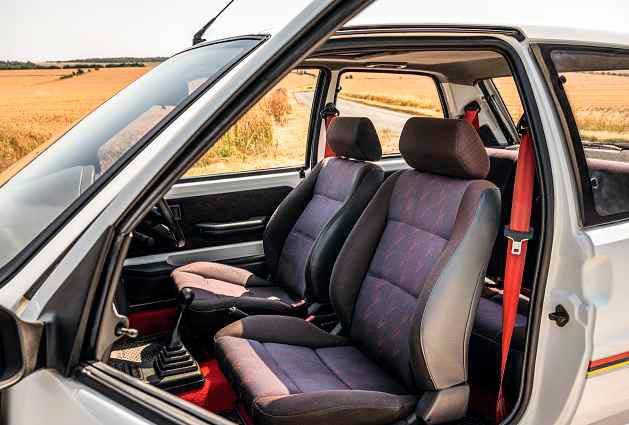
The brilliance in the Rallye’s chassis doesn’t take long to surface either. As soon as you’ve got past that slightly soft response, everything snaps taut like the steel cables of a shark net that’s just ensnared its prey. With 10 degrees of lock, the steering suddenly becomes very sharp indeed, and there’s the kind of organic feedback that all of us on evo dream of modern cars possessing. Little inputs have a big effect, and with the slack now taken up by the compressed sidewalls, the sensation is of a little car right up on its tippy toes, willing to have fun. Grip levels are not especially high, as betrayed by the gentle onset of a squeal from the tyres, but the Rallye does a lot with very little – and it’s all about the rear axle.
In classic Peugeot Sport fashion, it’s the torsion-bar rear suspension, and the way it reacts under load, that contributes a significant part of how the car handles. As a driver you feel confident on turn-in thanks to the steering, but there’s controlled oversteer here that seems to physically push you around the corner and to the exit, rotating the car automatically so that it’s best positioned for reintroducing the throttle. It’s not a strong oversteerer like a 205 GTI, but that magic is there all right: look at the rear cornering image on page 73, taken in a high-speed, fourth-gear corner, and see how this mild oversteer – barely detectable from the driver’s seat – has shifted the attitude of the car ready for the exit.
Like so many small, fast, French cars of the period, my Rallye ended up in a tree (literally), although it was repaired. I missed a random chance to buy it back ten years ago, and now wistfully think of it from time to time and wonder ‘what if’. As for the Rallye badge, it returned with the Series 2 106 in 1998 using the more mainstream 1.6-litre TU5 engine, which offered just a few more horses but noticeably more torque, had larger wheels and weighed a bit more at 865kg. It’s a faster car, but a less bespoke, exotic one. By now the 16v version of the TU5 engine had been dropped into a 106 to create the GTi, and competition activity (and group tests) focused more on this brilliant car; in some markets, the 16v was put into the Rallye trim, but not in the UK.
It almost goes without saying that they don’t make cars like the Series 1 106 Rallye any more. They can’t, for so many reasons, and there’s no will to make anything similar in any case. Perhaps the nearest to it is a Toyota GR Yaris, but that’s much more like a modern Lancia Delta Integrale.
Most of all, this is a car with an almost complete lack of pretension: there are no dark tinted windows, aggressive vents and spoilers or diamond-cut alloys. It manages 0-60mph somewhere between nine and ten seconds; it is not a car for impressing anyone, but it wears its motorsport stripes with pride and allowed even those on a small budget to own a proper homologation special, a dedicated driver’s car that was all about the thrill of driving, the passion of motorsport, and very little else. In that sense it’s a true evo icon. And anyway, if it was good enough to play a key role in the burgeoning career of a certain Mr Loeb, that really rather says it all…
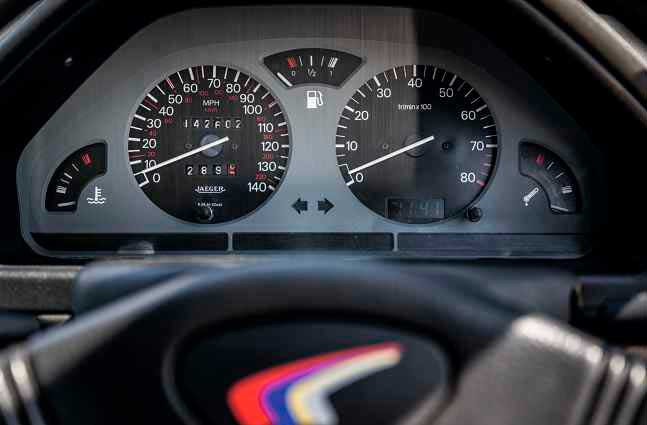
From far left: sports seats are decently supportive, if set a little high; instruments are a model of clarity – red line is set at a high 7200rpm; keypad for engine immobiliser was one of the few electrical gadgets
TECHNICAL DATA 1993 Peugeot 106 Rallye (Series 1)
- Engine In-line 4-cyl, 1294cc
- Max Power 100bhp @ 7200rpm
- Max Torque 80lb ft @ 5400rpm
- Weight 825kg
- Power-to-weight 123bhp/ton
- 0-60mph 9.3sec
- Top speed 118mph
- Price when new £9585
- Value today £10,000-£15,000
- DriveToday rating 3/5


